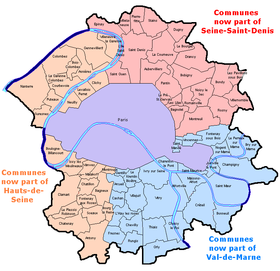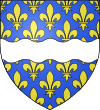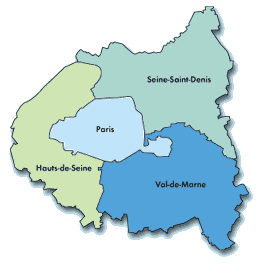
Hauts-de-Seine is a department in the Île-de-France region of France. It covers Paris's western inner suburbs. It is bordered by Paris, Seine-Saint-Denis and Val-de-Marne to the east, Val-d'Oise to the north, Yvelines to the west and Essonne to the south. With a population of 1,624,357 and a total area of 176 square kilometres, it has the second highest population density among all departments of France, after Paris. It is the fifth most populous department in France. Its prefecture is Nanterre, but Boulogne-Billancourt, one of its two subprefectures, alongside Antony, has a larger population.

In France, a prefecture may be:

Aisne is a French department in the Hauts-de-France region of northern France. It is named after the river Aisne. In 2020, it had a population of 529,374.

Yvelines is a department in the western part of the Île-de-France region in Northern France. In 2019, it had a population of 1,448,207. Its prefecture is Versailles, home to the Palace of Versailles, the principal residence of the King of France from 1682 until 1789, a UNESCO World Heritage Site since 1979. Yvelines' subprefectures are Saint-Germain-en-Laye, Mantes-la-Jolie and Rambouillet.

Oise is a department in the north of France. It is named after the river Oise. Inhabitants of the department are called Oisiens or Isariens, after the Latin name for the river, Isara. It had a population of 829,419 in 2019.

Seine-et-Marne is a department in the Île-de-France region in Northern France. Named after the rivers Seine and Marne, it is the region's largest department with an area of 5,915 square kilometres ; it roughly covers its eastern half. In 2019, it had a population of 1,421,197. Its prefecture is Melun, although both Meaux and Chelles have larger populations.

Essonne is a department in the southern part of the Île-de-France region in Northern France. It is named after the river Essonne. In 2019, it had a population of 1,301,659, across 194 communes.

Seine-Saint-Denis is a department of France located in the Grand Paris metropolis in the Île-de-France region. In French, it is often referred to colloquially as quatre-vingt treize or neuf trois, after its official administrative number, 93. Its prefecture is Bobigny.

Val-de-Marne is a department of France located in the Île-de-France region. Named after the river Marne, it is situated in the Grand Paris metropolis to the southeast of the City of Paris. In 2019, Val-de-Marne had a population of 1,407,124.

Val-d'Oise is a department in the Île-de-France region, Northern France. It was created in 1968 following the split of the Seine-et-Oise department. In 2019, Val-d'Oise had a population of 1,249,674.
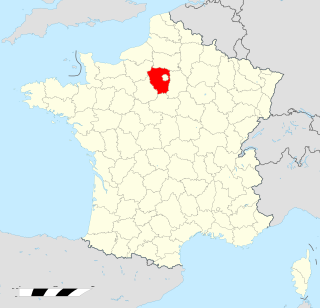
Seine-et-Oise is a former department of France, which encompassed the western, northern and southern parts of the metropolitan area of Paris. Its prefecture was Versailles and its administrative number was 78. Seine-et-Oise was disbanded in 1968 as part of the reorganisation of the departments of the Paris metropolitan area. The newly-created Yvelines department inherited the 78 number.

Argenteuil is a commune in the northwestern suburbs of Paris, France. It is located 12.3 km (7.6 mi) from the center of Paris. Argenteuil is a sub-prefecture of the Val-d'Oise department, the seat of the arrondissement of Argenteuil. Argenteuil is part of the Métropole du Grand Paris.
Montreuil most often refers to Montreuil, Seine-Saint-Denis, in the eastern suburbs of Paris, in the Seine-Saint-Denis département.
The Paris Fire Brigade is a French Army unit which serves as the primary fire and rescue service for Paris, the city's inner suburbs and certain sites of national strategic importance.
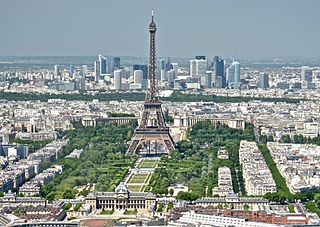
The Île-de-France is the most populous of the eighteen regions of France, with an official estimated population of 12,271,794 residents on 1 January 2023. Centred on the capital Paris, it is located in the north-central part of the country and often called the Paris Region. Île-de-France is densely populated and retains a prime economic position on the national stage, but it covers only 12,012 square kilometres, about 2% of metropolitan French territory, its 2017 population was nearly one-fifth of the national total.

The Paris metropolitan area is a statistical area that describes the reach of commuter movement to and from Paris, France and its surrounding suburbs.

The Île-de-France is a province of France encompassing the north-central departments of Val-d’Oise, Seine-et-Marne, Seine-Saint-Denis, Ville-de-Paris, Hauts-de-Seine, Val-de-Marne, Essonne, and Yvelines. It is bounded by the regions of Picardy (Picardie) to the north, Champagne-Ardenne to the east, Burgundy (Bourgogne) to the southeast, Centre to the south, and Haute-Normandie to the northwest. Its capital is Paris and it has an area of 4,637 square miles, and a population of 11,491,000 (2006).

The Council of Paris is the deliberative body responsible for governing Paris, the capital of France. It possesses both the powers of a municipal council and those of a departmental council for the département de Paris, as defined by the so-called PLM Law of 1982 that redefined the governance of Paris, Lyon and Marseille. Paris is the only territorial collectivity in France to be both a commune and a département.

Sarkozy's renovation of Paris, also known as the Grand Paris, is a vast public works programme commissioned by French president Nicolas Sarkozy between 2016 and 2030.
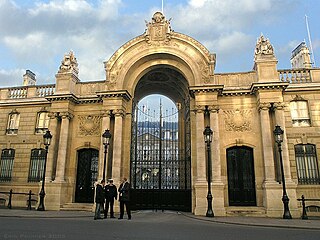
As the capital of France, Paris is the seat of France's national government. For the executive, the two chief officers each have their own official residences, which also serve as their offices. The President of France resides at the Élysée Palace in the 8th arrondissement, while the Prime Minister's seat is at the Hôtel Matignon in the 7th arrondissement. Government ministries are located in various parts of the city; many are located in the 7th arrondissement, near the Matignon.

